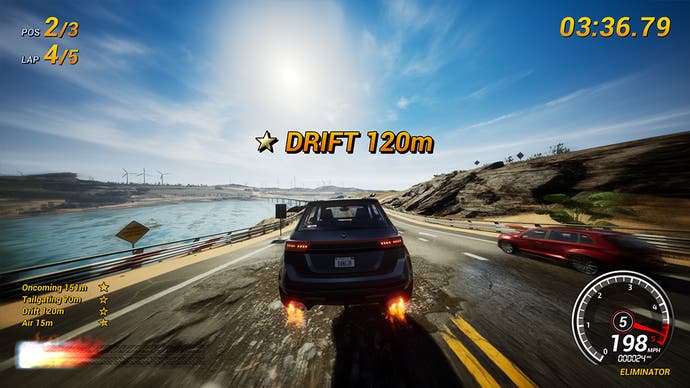Dangerous Driving represents the road not taken by Burnout 4
Smashing.
Dangerous Driving is Burnout, but what kind of Burnout is it? This question shouldn't be easy to answer because, like Tetris, Burnout is one of those games that was always, secretly, reworking itself. Burnout 3 introduced takedowns, for example, the ability to strike a rival once you had crashed, steering your own wreckage through the thick, sparking air for fun and profit. Burnout 4 took that idea and turned it into traffic-checking, which meant that any cars you hit that were travelling the same way as you would suddenly begin to bounce down the road, taking out anything and everything in their path. And then Paradise took the whole thing open-world.
So let's get surgical for a moment. Dangerous Driving belongs after Burnout 3 - takedowns and their attendant slo-mo are all in place. And it belongs before Burnout 4 - traffic-checking is not included. It represents, I think, the road not taken by 4. It has its own big idea, yet while it's different from traffic-checking it still has this sense of continuity, this sense of having emerged from the latent potential of those brilliant takedowns.
A few weeks back I went to play Dangerous Driving at the lovely bucolic office of Three Fields Entertainment, a small team - just seven, I gather - that is built around a core of personnel who all worked on Burnout back at Criterion. Three Fields has turned out a handful of games over the last few years, and there's a palpable sense that they've all been building to this one. To revisit a few, we've had the Burnout sensibility reworked as an indoor chaos simulator in Dangerous Golf, and we've had Burnout's Crash Mode reworked in Danger Zone. Dangerous Driving, though, is Burnout itself, back on the twisting, bucking, beautiful canyon tracks that made the series famous, earning boost by driving badly - but driving badly well - and then switching between boost and drift as you take on some astonishingly aggressive AI.

I discover Dangerous Driving's big idea on my second lap of the first course in the game. I'm racing through the wilderness, and early on I take out a few rivals, one on a bend, one on a straight. Everything, I would say, is going okay. I am boosting too much, as I always do, but I am back in love with that special Burnout grippiness, the way your car feels suctioned to the road like a powerful vacuum cleaner. Anyway, one lap down and I am feeling good. And then I crash. Not into a rival or part of the scenery - always a danger with me - but into the remains of a rival, the remains of a rival I smashed into oblivion on my first lap. Wrecks stick around now. That's the big idea.
And it's a beautiful idea, really. It mints procedural-style surprises from your own actions. It means that your behaviour in the game can dramatically alter the racing line. Say you like to start each game by barging people out of the way to build up boost. This was unambiguously the right thing to do in Burnout 3 or 4. In Dangerous Driving, it's ambiguously the right thing to do. You get boost, sure, but you also litter this part of the track with clutter that you're going to have to avoid. I love to take out rivals on the corners, and that's absolutely a terrible thing to do this time, because corners are already so villainous. And yet! And yet! It's so thrilling to do, so tempting. It's hard not to do it.
This brilliant idea brings fresh life to a bunch of excellent modes that spread across the campaign, from standard races to one-on-ones, fast laps and eliminators, road rages and something called Survival, where it's just you and a ticking clock and a bunch of checkpoints and the urge to make the whole thing last as long as possible. Every mode has a clever twist or two, but the thing that immediately makes them all classics for me is just how much your actions matter. Those wrecks! They are almost always my undoing. Well, the wrecks and the rival AI, which really isn't screwing around. And the tracks themselves that twist and turn and get their revenge on everyone who ever said that some of Criterion's later games lacked much in the way of corners.

It's a beautiful game, too, bright colours and sharp edges and plenty of Burnout sparks. Sure, it runs at 30fps on standard consoles - 60 on Pro and One X and, I think, on PC - and multiplayer is coming post-release, but this is a surprisingly massive game made by a team of seven, a team that has had to pick its battles.
And that set-up comes with its blessings anyway. Burnout has always been a focused kind of game, but Dangerous Driving feels particularly sharp. You drop in and seconds later you're swept away towards the horizon, where ghosts of your own actions now await you.

